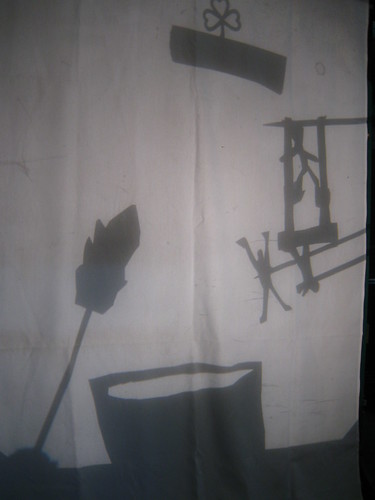
This summer I had a week-long gig co-teaching a puppetry class at Wheelock Family Theatre. It was my first time teaching puppetry. For two hours and forty-five minutes a day over the course of five days, my co-teacher, two assistants, and I, met with a group of roughly two-dozen nine-to-eleven year olds. Our objective was to teach them both puppet making and puppet performance. For me one imperative was that the kids came away introduced to at least three styles of puppetry and the associated techniques-- the other was that they created the work themselves.
On day one, we introduced them to the construction of rod puppets, and gave them the homework assignment to bring in a found object that would be modified into puppet. On the third day, I introduced them to shadow puppets using an overhead projector (a style of shadow puppetry covered extensively in Theatre on a Tabletop: Puppetry for Small Places by Kuang-Yu Fong and Stephen Kaplin of Chinese Theatre Works)
(All photos by yours truly while I was operating the overhead projector.)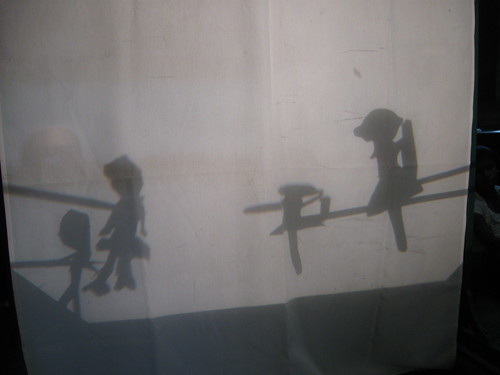
The kids were split into teams of three and sent to create circus-themed acts, which proved to be some of the most well-received aspects of the show they gave on Friday.
And now, a human tower on a unicycle!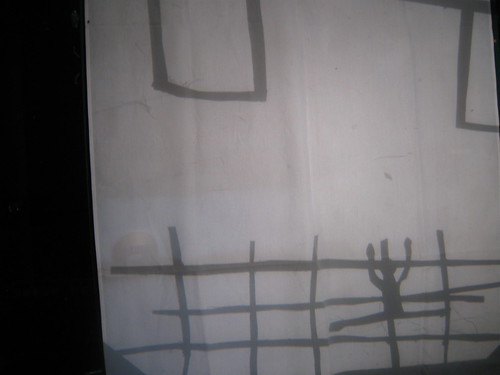
Don't worry, folks: we have a net!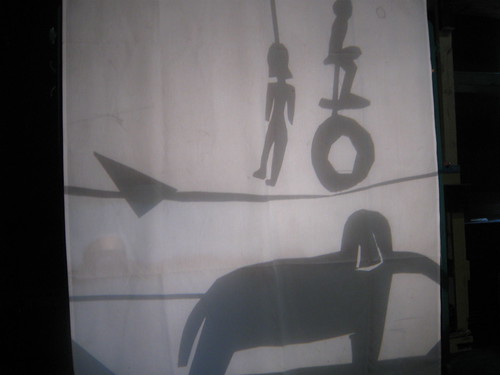
A tight-rope, a unicycle, and an elephant!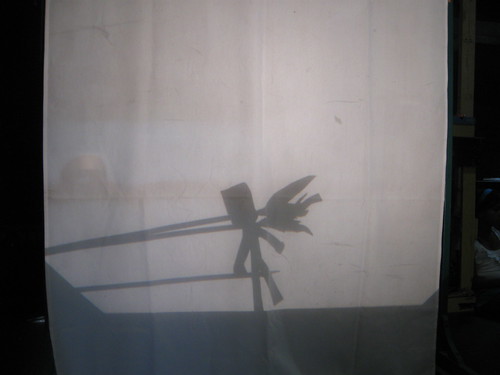
And now, ladies and gentlemen! The fire-breather!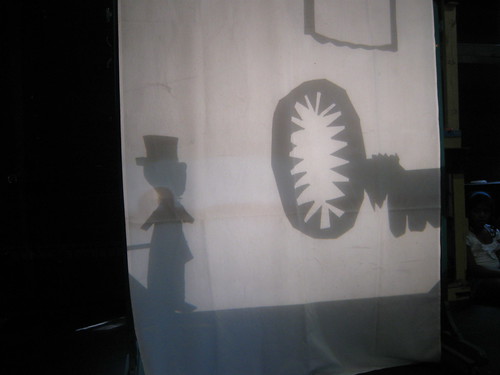
Can the most fearsome of beasts jump through a hoop of the most fearsome of elements?
Monday, July 19, 2010
Shadow Circus at Wheelock Family Theatre
Posted by
Ian Thal
at
8:50 PM
1 comments
![]()
![]()
Labels: Chinese Theatre Works, Puppetry, Shadow Puppets, teaching, Wheelock Family Theatre
Sunday, April 6, 2008
Can You Identify These Puppets? Part II
Last summer, I asked my readers if they could identify two Javanese Wayang Kulit puppets I had acquired at a yard sale.
So far we have had a number of opinions, but still no definitive identification of our two figures, other than a consensus that they are Javanese and not Balinese in origin (which is what the seller informed me)-- one anonymous poster identifies them as being specific to Central Java.
The first figure, who has a red face, an elaborate headdress and a gold body certainly seems to be of noble or royal office, but we are still no closer to putting a name to him. One friend of mine suggested that he was Rāvana from the Rāmāyaṇa but that contradicts the seller's statement that both figures were from the Mahãbhãrata. Indeed the previously cited anonymous poster suggested:
the first charachter might be Baladewa [...] definitely not Ravana.
Of Baladewa, I know nothing, and of whom I have yet to find an English language reference-- I do not even know if he goes by another name.

The second, smaller, blue figure was clearly of a lower status than the more elaborately dressed figure, and I was eager to assume that he was one of the comical figures of the Wayang known as punokawan but my anonymous poster seems vehemently opposed to that hypothesis.
The second (the blue guy) is definitely NOT a punakawan.
Once again, can any reader identify these puppets? How can one know that they are one figure and not another of similar status? I would so like to know their names so that I can learn their stories.
Posted by
Ian Thal
at
9:06 PM
5
comments
![]()
![]()
Labels: Mahãbhãrata, Puppetry, Rāmāyaṇa, Shadow Puppets, Wayang Kulit
Saturday, August 25, 2007
Can You Identify These Puppets?

Earlier this summer, I chanced upon a garage sale only a block from home and found these two shadow puppets. After inquiring as to their price I was given an offer I could not refuse. They are part of the tradition of Wayang Kulit, the shadow puppet theatre of Indonesia. I had first seen puppets of this nature at the Smithsonian's Arthur G. Sackler Gallery of Asian Art in Washington, D.C., likely when I was on break from college. While the soon-to-be former owner was able to tell me that these puppets were of Javanese origin (as opposed to the Balinese puppets I had seen at the Sackler) he could only identify them as figures from the heroic epic, the Mahãbhãrata.
So, dear reader, can you help me identify them? It is clear that the red faced fellow is a prince or noble of some sort, and that the blue fellow is of lower status, but is he a lower-ranked prince? A servant? Perhaps one of the comical figures of Wayong known as punokawan who, from their description, seem analogous to the zanni characters I often play when I perform commedia dell'arte?
Click here for the full photo set. My apologies as they are not my best photographs.
Posted by
Ian Thal
at
10:18 PM
7
comments
![]()
![]()
Labels: Mahãbhãrata, Puppetry, Shadow Puppets, The Smithsonian Institution, Wayang Kulit, zanni


